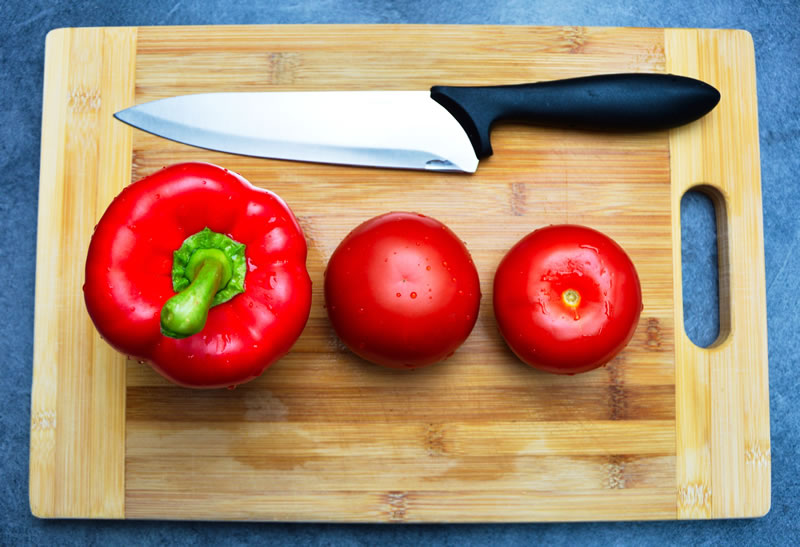


 WEBSITE
YOUTUBE
WEBSITE
YOUTUBE

BUY MEAT PROCESS THE MEAT MARINADES/SAUCES EQUIPMENT NEEDED
I like to make beef jerky and give some of it away to friends and family. Every year I make about 20lbs of dried meat, and I like to make it myself so I know exactly what's in it. More importantly, what's NOT in it - like extra nitrates, sulfur, and whatever other preservatives you will find in commercial jerky.
I'm lucky to have a restaurant supply store near me, so that's where I go to get my beef at a decent price. Your local butcher shop, Costco, and Sam's Club are other good sources. You can ask the meat department for an entire roast instead of buying individual steaks - but fair warning - it's a lot of work to process!
London Broil is best because it's very lean - but it's expensive! I usually buy a 20-pound Bottom Round or Top Round roast. It takes a bit of time and effort to trim off all the fat and marbled meat, but I normally end up with 10 to 15 pounds of good jerky-making steaks, and between 5 and 8 pounds of meat suitable for grinding into hamburger.
You will need one or more long, sharp knives. I usually get out two knives and sharpen them both before I start so I don't have to stop and sharpen in the middle of processing the roast. You will also need a large cutting board, and at least two large bowls or platters to sort your trimmings and steaks. And... you will need a meat dehydrator or at least cookie sheets and parchment paper (if using the oven).
Pro Tip: Make your marinade(s) first so that the spices have time to "marry" before you add your meat.
I start with the giant roast sitting in the clean/washed kitchen sink (still in the bag it came in). Carve off a chunk about 5 to 8 lbs, and start trimming off all the parts I don't want for jerky. Keep in mind that you want the leanest parts of the roast, and don't worry about carving away some of the "marbled" meat to get to the "choice" jerky-making cuts. I typically will be generous in what I cut off because later I grind it along with some of the the fat into hamburger. You can also use the trimmings (minus the fat) to make steak tacos.
Once I get my "chunk" trimmed down, I cut it into steaks appx 1 to 2 inches thick. Stack those up in a pile, and go back to your giant roast to carve off another big chunk. Trim that down, cut into steaks - repeat this process until you have the entire roast processed into steaks, and a pile of "trimmings".
Now you start on your pile of steaks - cut them into strips no more than 1/4-inch thick. The thinner they are the faster they will dry, but too thin and they will dissolve in the marinade. It's a judgment call, based on your skill with a knife and the marinade you are using. A motorized meat slicer comes in handy. You may also want to lightly freeze your steaks before starting this process - it makes the meat stiffer and easier to cut.
You should now have a pile of thin strips - time to marinate!
Make up your own sauce, or use the recipes below. I highly recommend that you test small batches (appx 1/2-lb of beef) so that you know you like it before you commit $100 of beef to a certain recipe.
Add the sauce to the meat, and be sure to shake or mix it up several times, so that the sauce gets on every surface of the meat.
Put it in the fridge - at least 6 hours is good, overnight is better.
My brother likes to use 1-Gallon Ziploc bags, and I like to use 1/2-Gallon glass jars. Other options could include baking pans with lids, large bowls, etc. It's best if they seal or it will "smell up" your fridge
I've found that the jerky I make takes 5 to 7 hours to dry. I use a dehydrator with trays, and my brother uses his oven set on 200deg. I'm sure there are other methods, but that seems to work best for us.
Lay out the marinaded strips on a grill or tray with a small amount of space in between the slices. You may want to wear "rubber" gloves, especially with the spicy recipes and large batches, as it can burn your skin handling 15lbs of spicy beef strips.
About half-way thru the drying process you should turn the slices over. I usually check it every couple of hours to see how it's doing so I don't over-dry it. It can get really crunchy and hard to eat if you let it go too long.
These are all "baseline" recipes. You can easily play with them and modify the ingredients to your liking. When I try something new, I write it down just in case I want to repeat a successful batch. Below you find the results of my more successful experiments.
![]() = Our Most Popular Marinades
= Our Most Popular Marinades
![]()
![]()
![]()
![]()
![]()
My personal favorite! Hits the trifecta - Sweet, Spicy, Salty!
Variations: If you like it really hot - add more Red Pepper, or try Black Pepper in addition!
![]()
![]()
![]()
![]()
![]()
This is a family favorite. Everyone likes the sweet-salty-tangy flavor. You should reduce the marinade time, the lime juice seems to break down the beef quickly. If you let it go too long you'll end up with a pile of mush instead of strips... I know from personal experience (smirk).
Variations: You can also try lemon juice, it comes out a bit sweeter. Or pineapple juice? I bet that's tasty!
![]()
![]()
![]()
![]()
This is a favorite of mine, but not everyone likes black pepper. It comes out nice and peppery, with just a hint of sweet.
Variations: If you REALLY like black pepper - double it! If you like sweet and heat - replace the honey with appx 6 Tbsp of Sweet Chili Sauce.
![]()
![]()
![]()
![]()
I know I keep repeating myself - but this is another of my favorites.
Variations: If you like sweet and heat - add some of Sweet Chili Sauce.
![]()
![]()
![]()
Simple, salty and not spicy. Excellent base to try variations.
![]()
![]()
![]()
Another early-days trial when I started making jerky. The kids love it - probably because it tastes like candy.
Variations: If you like sweet and heat - add a few Tbsp of Sweet Chili Sauce. Fair warning - the honey does make the finished jerky a bit sticky.
![]()
![]()
One of my earliest "experiments" in making jerky, and I still make it quite often. It's really good, but you have to like worcestershire sauce. My kids do not like it because it comes out with a bit of a cinnamon/nutmeg flavor.
![]()
I like this one, but you have to really like wasabi to enjoy this recipe. It has an unexpected flavor and a slow heat that creeps up into your nose after you've already swallowed a bite. Be careful of the marinade time, the wasabi seems to dissolve the beef faster than the other recipes.
WARNING: Try a small batch first! Not all wasabi powder is the same... so test this out before you make a big batch. The drying process concentrates the flavor. Protective gloves are recommended, the sauce can burn your skin.
If you are looking for some products that can assist you in your jerky making, take a look at the offerings I've listed below. I marinade in 1/2-gallon wide-mouth glass jars, and I have found the mason-jar vacuum sealer to be very useful. It cuts the marinade time down considerably. It pulls out all the air from between the meat fibers, and allows all the juicy goodness to get in there. So much deliciousness!
Ten stainless steel trays! Temp control and built-in timer! This thing looks awesome! I wish I had one.
From the Amazon description:Sometimes you can't get away from plastic... this is one of those times. However, this is a very useful tool when paired with the FoodSaver vacuum sealer you may already have. When I marinade mushrooms or meat in a half-gallon glass jar this cuts the time down by half! Works with both regular and wide-mouth canning jars.
From the Amazon description:If you don't have a FoodSaver vac sealer, there are some other options if you search for them.
I have a set of these. The best thing about them is that I can put them in the dishwasher without damaging the handles. I have a set of wooden handle knives, and they get really dried out if I put them in the dishwasher.
From the Amazon description:I use one that is very similar to this. Really useful when processing large things like a 20-pound roast or an entire turkey.
From the Amazon description:I have a set of these, and they are great! Sturdy, dishwasher safe, and all stainless steel.
From the Amazon description:These are really large! A little over one gallon, they really hold a lot of... "stuff". And they look great, with an "old-time" pioneer feel. They use the old-school lever-latch system, and have a glass top with a silicon gasket to seal them. Jars and lids can go in the dishwasher for easy cleaning! Great for storing dry pasta, cereal, or making pickles. A tried and true method that's been around since the covered wagon era.
From the Amazon description:Great for cutting veggies and meat, putting hot dishes on, and as a serving tray.
